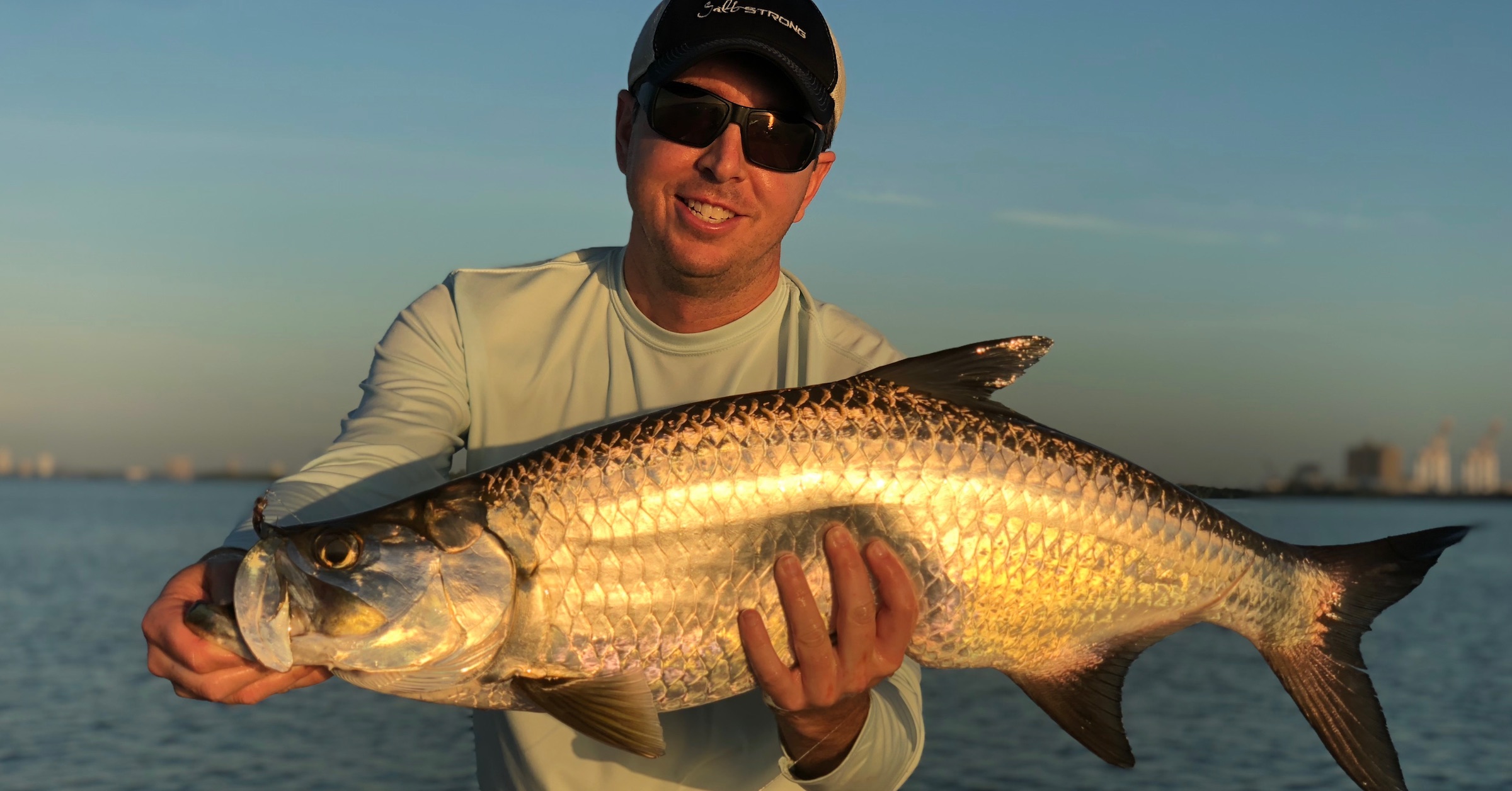What’s The Best Tarpon Fly For Backcountry Tarpon? [Input Needed]
- By: Luke Simonds
- on
- Found In: Fishing Tips, Fly Fishing, Inshore Fishing, Tarpon Tips

It’s tarpon time!
I’ve been seeing a lot of small tarpon roll in the back bays down in Bokeelia.
They’ve been picky eaters and I’ve been having bad luck with soft plastics, so I figured it was time to bust out the fly rod.
Now, the point of this video is going to be a little different than most.
My goal is to hear from you…
I want to know what your favorite tarpon flies are.
Do you have a favorite color?
A favorite size?
A favorite fly pattern?
Let me know in the comments below!
And check out this video to see me jump several tarpon, as well as the fly I was using (plus the sneaky tactic I pulled that caused me to lose the biggest one).
Which Is The Best Backcountry Tarpon Fly? [VIDEO]
I don’t fly fish nearly as much I’d like to, so feel free to share advice about my casting skills in the comments, too!
Conclusion
Alright, let’s get the discussion going!
What’s the best fly for backcountry tarpon?
What’s your favorite:
- Color
- Size
- Fly pattern
Let me know down in the comments!
P.S. Want to catch more and bigger tarpon? Get Tarpon Mastery here.
Do You Want To Quickly Find New Fishing Spots In Your Area?
Then you’ve got to see this private fishing club!
Here’s what you’ll receive today:
- Weekly fishing reports and TRENDS revealing where the inshore fish are feeding all year long
- Weekly “spot dissection” videos that walk you through all the best spots in certain areas
- Exclusive fishing tips from the PROS you can’t find anywhere else
- Everything you need to start catching fish more consistently (regardless if you fish out of a boat, kayak, or land).
Click here to join today.
Related articles:
Related categories:
STOP WASTING TIME ON THE WATER!
Do what the “SMART ANGLERS” are doing and join the Insider Club.
Here’s what you’ll receive today when you join:
- Weekly fishing reports and TRENDS revealing exactly where you should fish every trip
- Weekly “spot dissection” videos that walk you through all the best spots in your area
- Exclusive fishing tips from the PROS you can’t find anywhere else
- Everything you need to start catching fish more consistently (regardless if you fish out of a boat, kayak, or land).










Hello everyone, not an expert by any means! However, my first (and only) two takes by juvenile tarpon on the fly so far, were on a dragon tail streamer with a marabou head. Both tail and marabou white, pink thread. With lots of large mullet around, I threw the biggest fly I had.
The hook was my problem, a number two stinger hook, I just kind’ve whipped the fly on for fun. I feel like if I had used something a little more specialized, I could’ve connected.
As Robert stated, I too feel like slow is key, both strikes I was just watching the fly dance as slow as possible, and was startled by the takes. Strip set, strip set, strip set. So easy to say, so hard to do with weak knees!
Thanks for making time to leave the helpful comment Col!
I fly fish some every day and have been playing with the tarpon as well. I am using a small white glass minnow fly on 20 lb leader. They are a challenge to bring in on the small fly, I land about 1 out of 10 but it is a blast.
I’m no pro and am self taught on the fly rod. When I started I could only get the line out about 10 ft however once I learned to slow down and let the rod load naturally my distance increased, I now average 60-70 ft. Hope this helps a little.
Thanks or making time to leave the helpful fly casting tip comment Robert!
Hey Luke! I’m still new to the sport and happy to share what I’ve experienced thus far.
The juvenile tarpon appear to be feeding on small forage (i.e. glass minnows, gambusia minnows, and/or varieties of fry) in the areas I fish. In turn I tend to pitch small 2 1/2 to 3″ minnow patterns and seaducers as well. Typically; some variation of white or black & purple. Most of the waters I frequent are shallow and typically dont tie or use flies with much weight. If so; medium bead chain is my ceiling preference to either get the fly to ride a little bit deeper or to assist with off-setting the buoyancy of some tying materials. If the wind picks up a bit too much I may tie one on with extra small lead to compensate – punching through and a little better control of accuracy.
Something I noticed when viewing the footage was the set. I experienced similar challenges myself when going from spin to fly. At this point in your fishing journey it’s an involuntary action to lift or quick snap (up or to the side) when you feel that thump. As Robert mentioned, strip set with the rod tip down; pointed at your line. You want that inital load at the strike to be all line as lifting too soon will create an inferior set and introduce slack typically resulting in a lost fish.
Something else to be conscious of in regards to the set; your strip distance during retrieval. Longer strips are sometimes required either to entice a strike or impart better action with flies tied with more supple materials such as marabou, craft fur, polar fiber. Doing so introduces the potential to lose hook setting power the further away your strip hand is from your rod hand. Not that you need to rear ALL the waaaaay back with your stripping hand to set; just firm sharp tug.
Casting may be best learned by working with an instructor or an individual with plenty of experience. It’s much tougher to unlearn bad habits down the road. Personally, I haven’t made the investment myself and continue to see the results with missed opportunities when on the water.
In closing; keep in mind at times tarpon are going to be tarpon. Finicky, hard to stick, and harder to keep hooked! I’m just happy to put a few in the air!!!!
Tight lines and wishing you well!
JA
Great tips John! Thanks so much for sharing the very helpful details.
Hi Luke, I live in Key Largo and pretty much fly-fish exclusively in Everglades Park and the keys almost every day. I find the juvenile tarpon are much easier to catch especially when they are rolling early in the morning. Also, they are much easier to catch than the larger ones, and the fly patterns I use for the juvenile tarpon will usually will not work with the larger more experienced tarpon. My favorite fly is a shrimp pattern on a number 2 hook. Straw and brown color flies work best except in very dark or muddy water where a purple black color giving a clearer profile is necessary. Actually most snook and redfish flies will work for the smaller tarpon. I tie the fly with fake fur and put in a few orange and black stripes with magic marker. I also tie in a piece of gold flash and one strip of orange or brown legs. The very front of the fly has EP fiber or yellow fur that I spin. I use different weight eyes depending on the water depth.
Regarding suggestions about casting and hooking the tarpon, it is critical to keep the rod low close to the water and pull hard on the line without moving the rod giving a strip strike to penetrate the hook into the tarpon’s hard mouth. If you move the rod you will not penetrate the hook and you will have to move the it back creating slack in the line causing the Tarpon to jump off. Also, once hooked it is critical to always keep pressure on the fish by keeping the rod low to the water and pulling in the opposite direction that the fish is pointing. Lifting the rod in the air creates little pressure on the line. Also, be sure to bow to the tarpon when they jump giving them some slack. Once the tarpon is close to the boat, pull up lifting the head of the tarpon, but being careful for another wild blast of power and a jump.
I suggest taking a casting lesson. The best instructor is Jon Cave who is a Sage Ambassador located in Black Hammock FL which is just east of Orlando. He gives private and group lesson, and you will benefit tremendously. He also has a great book “Performance Fly Casting” which has great illustrations and costs about $16. Another great video aid is “The Complete Cast” from Temple Fork Outfitters where Lefty Kreh and Ed Jawarski give excellent instructions as well as some of the best explanation of casting faults and how to correct them. Apologies for being long winded.
Tight lines,
Bob
https://photos.app.goo.gl/xNBDt4jxvhriat4k8
Picture of flies
Great advice
Thanks so much for making time to leave these helpful tips Bob!!!
I second the Jon Cave recommendation. My son and I went through his casting course. This guy is incredible and had us making great loops in no time.
I have yet to catch one myself (my goal for this summer!) but I’ve heard of lot of fly anglers have success with any and all variations of the tarpon toad patterns, sizes 2-1/0. Black/purple for murky/stained water, I bet brown/tan does a good job imitating those crabs. Chartruese is a popular color during the day. Best of luck to you! Tarpon on the fly has gotta be a thrill. I’m dying to get on one.
Thanks for leaving the helpful comment Max!
Luke that was fun to watch. Your Jedi mind trick “the fish you seek are not here” was classic ????????
Thanks for making time to leave the nice comment Bruce!